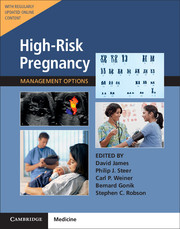Book contents
- Frontmatter
- Contents
- List of Contributors
- Preface
- Section 1 Prepregnancy Problems
- Section 2 Early Prenatal Problems
- Section 3 Late Prenatal – Fetal Problems
- Section 4 Problems Associated with Infection
- Section 5 Late Pregnancy – Maternal Problems
- 30 Substance Misuse in Pregnancy
- 31 Medication in Pregnancy
- 32 Hypertension in Pregnancy
- 33 Cardiac Disease in Pregnancy
- 34 Respiratory Disease in Pregnancy
- 35 Anemia and White Blood Cell Disorders in Pregnancy
- 36 Hematological Malignancies in Pregnancy
- 37 Thrombocytopenia and Bleeding Disorders in Pregnancy
- 38 Disorders of Coagulation in Pregnancy
- 39 Autoimmune Disease in Pregnancy
- 40 Diabetes in Pregnancy
- 41 Thyroid Disease in Pregnancy
- 42 Pituitary and Adrenal Disease in Pregnancy
- 43 Gastrointestinal and Liver Diseases in Pregnancy
- 44 Neurologic Complications in Pregnancy
- 45 Renal Disorders in Pregnancy
- 46 Spine and Joint Disorders in Pregnancy
- 47 Skin Disease in Pregnancy
- 48 Malignant Disease in Pregnancy
- 49 Pregnancy After Transplantation
- 50 Trauma in Pregnancy
- 51 Mental Health Disorders in Pregnancy
- Section 6 Late Prenatal – Obstetric Problems
- Section 7 Postnatal Problems
- Section 8 Normal Values
- Index
36 - Hematological Malignancies in Pregnancy
from Section 5 - Late Pregnancy – Maternal Problems
- Frontmatter
- Contents
- List of Contributors
- Preface
- Section 1 Prepregnancy Problems
- Section 2 Early Prenatal Problems
- Section 3 Late Prenatal – Fetal Problems
- Section 4 Problems Associated with Infection
- Section 5 Late Pregnancy – Maternal Problems
- 30 Substance Misuse in Pregnancy
- 31 Medication in Pregnancy
- 32 Hypertension in Pregnancy
- 33 Cardiac Disease in Pregnancy
- 34 Respiratory Disease in Pregnancy
- 35 Anemia and White Blood Cell Disorders in Pregnancy
- 36 Hematological Malignancies in Pregnancy
- 37 Thrombocytopenia and Bleeding Disorders in Pregnancy
- 38 Disorders of Coagulation in Pregnancy
- 39 Autoimmune Disease in Pregnancy
- 40 Diabetes in Pregnancy
- 41 Thyroid Disease in Pregnancy
- 42 Pituitary and Adrenal Disease in Pregnancy
- 43 Gastrointestinal and Liver Diseases in Pregnancy
- 44 Neurologic Complications in Pregnancy
- 45 Renal Disorders in Pregnancy
- 46 Spine and Joint Disorders in Pregnancy
- 47 Skin Disease in Pregnancy
- 48 Malignant Disease in Pregnancy
- 49 Pregnancy After Transplantation
- 50 Trauma in Pregnancy
- 51 Mental Health Disorders in Pregnancy
- Section 6 Late Prenatal – Obstetric Problems
- Section 7 Postnatal Problems
- Section 8 Normal Values
- Index
Summary
Introduction
The diagnosis of a hematological malignancy during pregnancy poses a major challenge to the pregnant woman, her family, and the medical team. Treatment of a pregnant woman with chemotherapy poses a risk to the fetus and raises therapeutic, ethical, and social dilemmas. A woman diagnosed with a hematological malignancy during pregnancy should be managed jointly by a multidisciplinary team comprising consultant hematologist, obstetrician, midwife, anesthesiologist, and neonatologist. Consideration should be given to the health of both mother and baby, with the informed wishes of the mother being considered paramount by the medical team. Psychological support should be offered to the woman and her family. Information giving should be supported by written information and a treatment plan. The woman should be fully informed about the diagnosis, her treatment options, potential complications, and the possible fetal and maternal outcomes.
Hematological malignancies can be broadly divided into myeloid and lymphoid tumors, according to the presumed cell of origin for each disorder. The incidences of myeloid and lymphoid hematological malignancies in the general population and summaries of the standard therapeutic approaches in the nonpregnant population are summarized in Tables 36.1 and 36.2.
• The myeloid tumors that will be considered in this chapter include:
– Acute myeloid leukemia (AML)
– Myelodysplastic syndromes (MDS)
– Myeloproliferative neoplasms (MPN)
– Chronic myeloid leukemia (CML)
• The lymphoid tumors to be considered include:
– Diffuse large B-cell lymphoma (DLBCL)
– Hodgkin lymphoma (HL)
– T-cell non-Hodgkin lymphoma (T-NHL)
– Follicular lymphoma (FL)
– Burkitt lymphoma (BL)
– Mantle cell lymphoma (MCL)
– Multiple myeloma (MM)
– Chronic lymphocytic leukemia (CLL)
Acute lymphoblastic leukemia (ALL), though technically a lymphoid tumor, is considered with AML because of commonalities in the approach to treatment.
Myeloid Tumors
Acute Leukemia
Acute leukemia diagnosed during pregnancy is uncommon, occurring in approximately 1 in 75,000– 100,000 pregnancies. AML represents approximately two-thirds and ALL one-third of cases.
The diagnosis of leukemia in pregnancy is more challenging than in nonpregnant individuals, since anemia and thrombocytopenia, which are common presenting features of acute leukemia, are common findings in pregnancy.
- Type
- Chapter
- Information
- High-Risk Pregnancy: Management OptionsFive-Year Institutional Subscription with Online Updates, pp. 1006 - 1043Publisher: Cambridge University PressFirst published in: 2017



